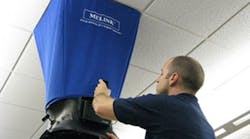Balancing a heating and cooling system that includes zoning requires several additional steps compared to a standard HVAC system. Without these extra steps, your customers may experience excessive noise and very low operating efficiencies. Let’s take a look at how these additional steps at the end of a balancing job can assure that customers will be delighted with their zoning systems for years to come.
A Visual Inspection
Because zoned systems have added components, inspect the system and compare the plan to what actually got built. This sounds really basic, but it’s a critical step required in balancing a zoned system..
Does each zone control operate the zoning damper when the temperature on the zone thermostat is increased or decreased? Does the fan speed adapt to each call for zoning or does the bypass damper function as designed?
Did each manual and zoning damper get installed? Are the manual dampers open? Are the supply registers delivering supply or return air?
Next inspect and check the zoning components: is the bypass duct installed if one is included in the design? Is the control panel wired correctly? Were all the dampers installed and connected? Does each of the dampers operate freely when called to function?
Added Labor
To begin balancing, this added balancing work increases the labor nearly 25% when compared to a typical system, so be sure adequate time is available to do the job right
Basically, you’ll have to balance the system with all zones calling, and then measure fan and grille airflows again with the largest zone closed. You’ll do this to check for noise and to assure the equipment temperatures remain within spec with reduced system airflow.
First, adjust the system and ensure each zone is calling for heating or cooling. This is accomplished by setting each zone thermostat to call for heating or cooling by increasing or decreasing the temperature setting.
Better zoning systems have a switch in the control panel that allows the balancer to do this. If not, set each thermostat in cooling mode at 55F with the fan on to open all the zoning dampers 100%.
The Initial System Balance
Using manual balancing dampers, balance each grille and register to the amount of airflow required under normal conditions. Balance the system as though it was a typical heating and cooling system. For more detailed balancing steps, see the balancing procedure offered at the end of the article.
Add together all the supply register airflows and check for 400 CFM per ton in cooling mode, or minimum-required airflow in heating mode.
Adjust the manual balancing dampers so each register gets the required airflow. The accepted rule is plus or minus 10%. Lock down and mark your manual balancing dampers. The system is now balanced under typical operating conditions.
Verify Pressures and Temperatures
If airflow is low, measure total external static pressure by measuring pressure before and after the air handler or furnace, then add the pressures together.
Measure the pressure drop over the filter and the coil. Increase fan speed as needed.
Perform final testing that includes system temperatures, static pressures, blower motor amp draw, and fan RPM. Record these numbers on your balancing report.
The Second Balance
Close down the largest zone in the system. Then traverse the bypass duct to check the volume of bypass air.
Then by manipulating zone thermostats, open and close each of the zones in the system. Test and record airflows and temperatures through the system with various zones calling. Check for noise caused by excessive air velocities.
As the zone dampers open and close, measure the airflow passing through the bypass duct again. Adjust it as necessary to assure quiet system operation and adequate temperatures through the heating and cooling equipment. Check for excessive changes in total external static pressures or temperature change in the system.
Finally, measure for pressure imbalances that may be caused when zone dampers open and close. Each zone should have a return air duct that can handle the airflow under the zones highest airflow condition.
Mark the Final Manual Damper Positions
Mark your final manual and bypass damper settings. Complete your final equipment testing by measuring and recording full open pressures, temperatures, speed, and electrical values. Complete the job as you would for a typical heating and cooling system.
Make any design change or repair recommendations that may improve the quality of the system, if necessary.
Take time to instruct the customer in proper use of their zoning system and help them understand what they can expect from their new system. Don’t forget to furnish your customer with a final digital or hard copy of the balancing report with all the required paperwork, warranty information, and a service agreement.
Rob “Doc” Falke serves the industry as president of NCI (National Comfort Institute), an HVAC-based training company and membership organization. If you're an HVAC contractor or technician interested in a procedure detailing how to balance a zones system, contact Doc at [email protected] or call him at 800-633-7058. Go to NCI’s website at nationalcomfortinstitute.com for free information, articles and downloads.









